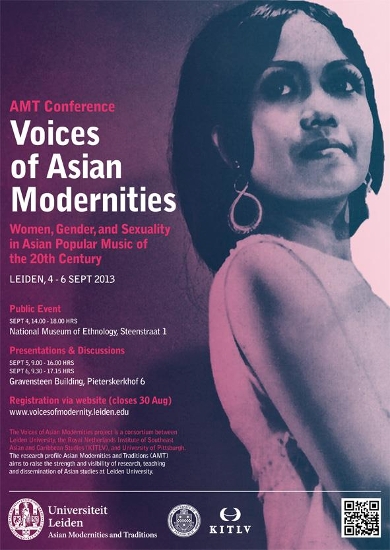Research project
Voices of Asian Modernities: Women, Gender, and Sexuality in Asian Popular Music of the 20th Century
What was the relationship between women and modern media in different parts of Asia in the 20th century? Under what historical and social conditions did women achieve prominence in popular music in Asia?
- Contact
- Bart Barendregt

Women and modernities in Asian popular music
Modernity and morality are often discursively produced as absolute and universal categories. An analysis of women, gender, and sexuality in comparative perspective enables us to illuminate the often-abstract notions of modernity and morality in specific historical and material circumstances.
By examining the local historical and cultural specificities of women in Asian popular music, we aim to understand the conjuncture that enabled women’s voices to emerge simultaneously with modernities in Asia. This comparative approach to Asian modernities, although focused on Asia, will provide useful data for studies of modernity in world and global history (or, what Arif Dirlik has called “global modernity”).
Social actors and role models
Emphasizing women as social actors in the history of the music entertainment industries, the VAMP project focuses on the female voice in Asian popular music and highlights the particularities of gender in the emergent Asian entertainment industries of the 20th century. These industries increasingly accommodated female stars as role models and changing ideas about gender followed. Scholars have noted that women are often ignored or left out of accounts of modernity (Felski 1995; Pykett 1995; Ardis and Lewis 2002). In contrast, this project aims to foreground the individuals, the gendered ideologies, and the popular music industries through which women’s voices came to enjoy a prominent and powerful place in Asian modernities. Comparison is a central analytical component of this project.
Artistic pioneers of change
This project aims to demonstrate how female entertainers, positioned at the margins of different intersecting fields of activities, created something hitherto unknown: they were artistic pioneers of new music, new cinema, new forms of dance and theater, and new behavior and morals. They moved from the margins to the mainstream and in their wake Asian pop cultures now have followed. These female performers were not merely symbols of times that were rapidly changing. Nor were they merely the personification of global historical changes. They were active agents in the creation of local performance cultures, of the newly emerging mass culture, and the rise of a region-wide and globally oriented entertainment industry.

Strategic use of gender
Studies of pioneering women in popular performing arts of Asia have shown how ideas of performance have been instrumental in the construction of new identities by questioning and rejecting conventional forms of presentation. For example, Asian performers play with ideas of “glamour” (defined as dressing up; allure; and enchantment), “camp” (artifice and exaggeration), and “kitsch” (sentimentality and melodrama) for strategic ends. These ideas, and others, will allow us to map the ways in which performers have articulated their own positions in specific contexts.
Voices of Asian Modernities conferences
The two conferences revealed how women in popular music contributed to new processes of social differentiation, of culture formation, and of history making. Conscious subversion of gendered behavior, parody, and strategic use of cultural stereotypes have not only been instrumental in the making of new fashions but have also found their way to a larger audience and society as a whole. Asian entertainment industries have as such not only seen the rise of the Asian diva, but they have also offered a productive playground for those experimenting with the effeminate and other alternative forms of masculinity, cross dressing, and sheer travesty. The upcoming volume will consider these forms, among others, as effects of female voices of modernity.
The first conference was held from 4 till 6 September 2013. It was hosted by the research profile Asian Modernities and Traditions (AMT) within the project 'Women, Gender, and Sexuality in Asian Popular Music of the 20th Century'. A second follow-up conference took place in Pittsburgh from April 4-6, 2014. Both conferences will result in a soon to be published volume edited by Bart Barendregt and Andrew Weintraub.
This project is a spin off from the Articulation Project and fits within the research scope of the Leiden research cluster of Asian Modernities and Traditions.
